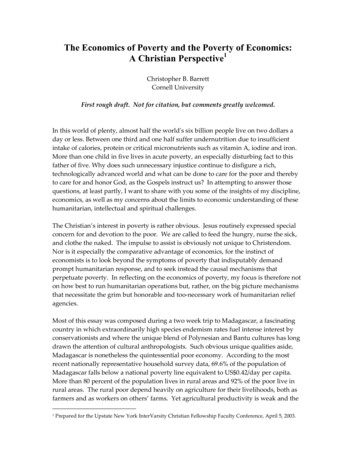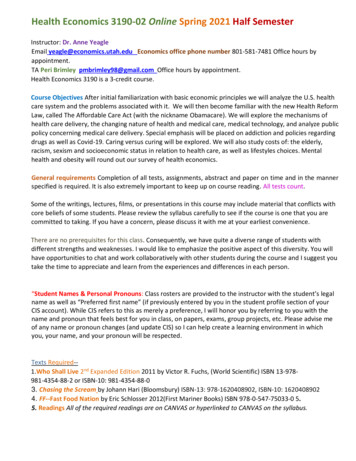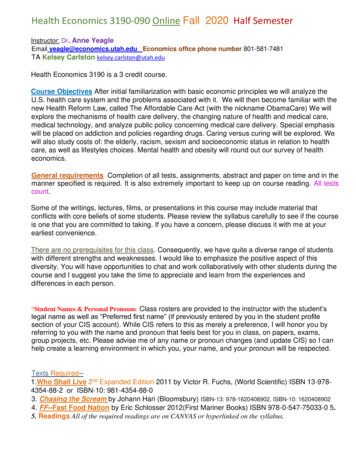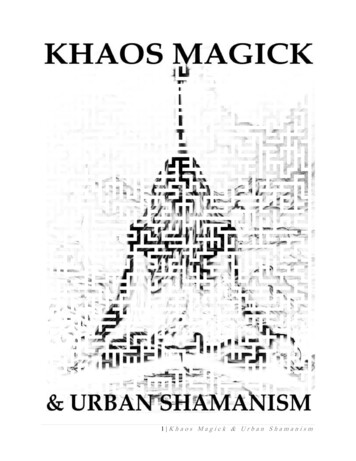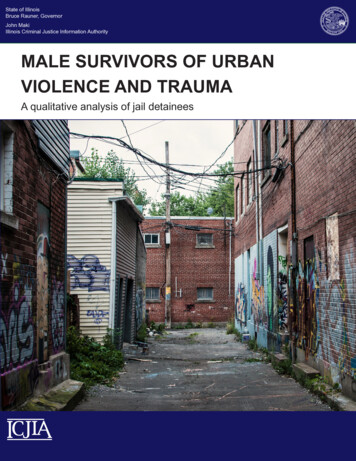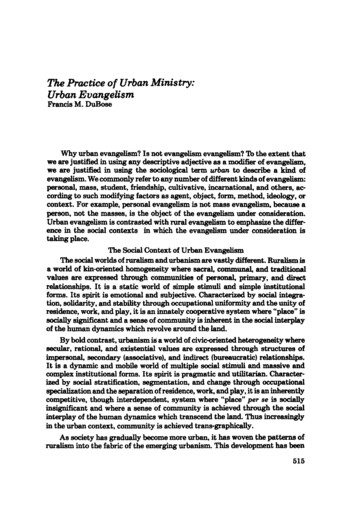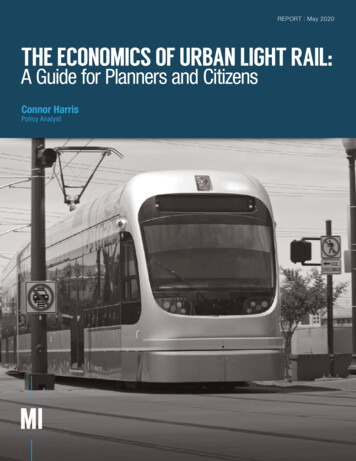
Transcription
REPORT May 2020THE ECONOMICS OF URBAN LIGHT RAIL:A Guide for Planners and CitizensConnor HarrisPolicy Analyst
The Economics of Urban Light Rail: A Guide for Planners and CitizensAbout the AuthorConnor Harris is a policy analyst at the Manhattan Institute, where he focuses on infrastructure,transportation, and housing policy. His writing has appeared in publications such as City Journal,the New York Post, and the Harvard Political Review. Harris graduated from Harvard University in2016 with a B.A. in mathematics and physics.2
ContentsExecutive Summary.4I. Introduction .5II. What Drives Transit Ridership? .6III. Common Problems in Light Rail Planning.8IV. Conclusions.11Endnotes.143
The Economics of Urban Light Rail: A Guide for Planners and CitizensExecutive SummaryMost U.S. cities dismantled their streetcar networks in the first half of the previous century, but in the past fewdecades, some transit agencies have restored them, with help from generous federal grants. Modern light railsystems have appeared in more than a dozen U.S. cities, many of which had little preexisting transit ridership.They run small trains, often in the middle of wide streets along disused rail lines. Proponents of light rail arguethat it is cheaper than a full subway line and can carry more riders than buses, as well as attracting new riders byoffering a more comfortable ride. One study from 1989, for example, finds that rail systems get 34%–43% betterridership1 than bus lines with equivalent service.This trend has had critics, including general opponents of public transit2 and pro-transit urban planners,3 whoargue that light rail service is costlier and less flexible than bus service. This paper aims to help planners andcitizens evaluate when new light rail lines are justified. First, we will explore the economics behind the choicebetween light rail and buses, as well as how to determine the best locations of lines. Our analysis of ridership on23 U.S. light rail systems shows that proximity to development and jobs is necessary for success. Unfortunately,very few places that are not already served by light rail systems have the features necessary to make them viableand would be better served by expanded bus service.Further, we highlight several common errors that light rail planners have made: overexpansion of systems intolow-density areas; overvaluing certain classes of destinations such as airports; and the use of low-quality rightsof-way that sacrifice ridership to avoid political controversies during construction. These errors have led to theconstruction of many existing light rail systems in fundamentally unviable areas.Although we close by offering a brief list of suggestions for optimizing the efficiency of existing light rail systemsand for evaluating expansions, our analysis ultimately suggests that many proposed expansions, and even someexisting systems, should be canceled or closed. Outside a handful of areas in the U.S., bus rapid transit (BRT)offers a better, more economically sustainable path forward.4
THE ECONOMICS OF URBAN LIGHT RAIL:A Guide for Planners and CitizensI. IntroductionThe abstract economic case for light rail is simple. Though light rail requires more expensive infrastructure thana bus line, it requires fewer employees to carry the same number of passengers. The Kinki Sharyo light rail trainsin use in Dallas, for example, can hold 94 passengers seated or 274 at maximum crowding, or “crush load,”4 morethan twice what an articulated bus can. Moreover, light rail vehicles, unlike buses, can couple to form longertrains. In regions where driver wages are expensive relative to infrastructure costs, light rail may be cheaper thanbuses by allowing the same capacity with fewer vehicles.Empirical data, however, call this case into question. One study using an abstract model of a transit network andcost parameters taken from Sydney, Australia, found that the operational costs of light rail systems, includingboth operating costs and the value of passengers’ time, are a few percentage points higher than those of BRTsystems under a wide range of modeling assumptions, except possibly in systems that received more than 3million passengers per day.5 Another literature review finds an operating cost premium of 59% for light rail overBRT per unit of capacity, based on studies from 1993 and 2001.6 Data from the 2018 National Transit Databaseagree that light rail is more expensive to operate, costing 12%–505% more per vehicle-hour in the cities that weresurveyed. The highest light rail premium is in Oceanside, California, while the median light rail cost premium is108%, in Pittsburgh.7Capital costs, likewise, are generally lower for buses than for light rail. One of the least expensive recent light railprojects is a 14.5-kilometer line in Besançon, France, which opened in 2014. The project cost 249 million, orroughly 35 million per mile.8 The city government lowered the project cost by soliciting more bids than usual,using simple, standardized station designs, and minimizing street beautification and reconstruction.9 Typicallight rail projects cost more, though costs vary widely. The recent T7 line in Paris, for example, cost 228 millionfor 11.2 kilometers, or about 40 million per mile,10 and the transportation writer Alon Levy gives a range of costsat about 25 million to 80 million per mile,11 though a planned extension of the T7 is estimated at 223 million(at 2011 prices) for 3.7 kilometers and six stations, or about 115 million per mile.12Costs in the U.S. are generally somewhat higher. The Valley Metro Rail project in Phoenix, completed in 2008,cost about 85 million per mile in today’s money. The final stage of the DART Orange Line extension to Dallas–Fort Worth (DFW) airport, which was finished in 2014, cost 83 million per mile in today’s money, though thisproject included only one station and would have cost more with a more typical station spacing.13Because buses rely on preexisting roads, the cost of a bus line, at minimum, is just the cost of buses themselvesas well as bus shelters. Nevertheless, many cities have implemented BRT systems, which include infrastructureimprovements such as fancier stations, off-board fare-collection machines, raised boarding platforms for mobility-impaired passengers, and dedicated lanes.5
The Economics of Urban Light Rail: A Guide for Planners and CitizensThese systems can cost a large fraction of what lightrail does, though they are still generally cheaper. Costsof BRT projects vary widely: one paper from 2005, forexample, found that costs varied by almost an order ofmagnitude.14 A 2001 report from the U.S. GovernmentAccountability Office gave an average cost of BRTwith full busways as 13.5 million per mile (about 20million today), about 39% of the 34.8 million costof light rail (about 50 million today).15 More recentsystems have tended to be more expensive: a surveyof recent U.S. BRT systems by the planner Ari Ofsevitfound that costs varied from 27 to 60 million permile.16 There was one low-end outlier, at 6 millionper mile: a narrow one-lane busway in Eugene,Oregon, whose planners scheduled buses carefully sothat buses could run in both directions despite onlyhaving one lane.Nevertheless, in general, the difference between lightrail and BRT capital costs is about 30 million permile, with a wide margin of variability. This is an additional 1.37 in capital costs per ride if amortizedover 20 years with daily ridership of 3,000 riders perroute-mile, typical for the higher-performing U.S.light rail lines.These conclusions should be taken with a grain ofsalt. Construction costs vary widely, and, in certaincircumstances (for example, if a preexisting rail linecould be converted easily for light rail), light rail maybe cheaper. But on the whole, transit agencies shouldassume that replacement of bus service with light rail,unless buses are already overcrowded, will increase operational costs.Improved capacity and reliability may still makethe conversion worthwhile. A phenomenon called“bunching” limits the frequency of bus service. If abus is slightly delayed—say, by missing a traffic light,or by a disabled passenger who needs additionaltime to board—more passengers will accumulate atsubsequent stops while the bus is delayed. The busmust then stop longer to let the extra passengers board,causing a vicious cycle of delays and overcrowding.Eventually, less crowded buses farther back will catchup to the delayed bus in front.Some BRT improvements can ameliorate minor bunching by providing more reliable travel and boardingtimes. Nevertheless, bunching remains a fundamental cap on bus capacity. One expert on BRT suggeststhat bunching makes the frequency of more than 30buses per hour impossible, and 22 is ideal.17 Some BRTsystems manage higher frequencies by using freewaylanes with no traffic crossings, closing most crossstreets, or by using four lanes of a road to allow buses6to pass each other—but installing such systems in mostdowntown areas is impossible or disruptive. A 2009literature review suggests that, overall, light rail has a65% capacity increase over BRT.18Despite high potential capacity, actual ridership onU.S. light rail systems is low. Boston’s Green Line—which is a small component of a far more extensiveand faster subway system—had 6,951 boardings perroute-mile on an average weekday in 2018. Only fourother systems garner more than 3,000: San Francisco (5,088), Seattle (3,768), Minneapolis (3,411),and northern New Jersey (3,032, including the Hudson-Bergen Light Rail and the Newark Subway).19Most trams in Europe, even those in very small cities,perform much better. In France, for example, thetrams in the Paris region, located in relatively peripheral areas, garnered about 12,600 riders per route-mileon an average weekday in 2017.20 The 41.1-mile Bordeaux tramway in Bordaeaux, meanwhile, received105.5 million riders in 2018, or an average of 7,000per day per route-mile, including weekends.21 Evenmost light rail systems in Canada get much higher ridership than in the United States. Calgary’s CTrain, forexample, is 36.7 miles long and got 312,300 riders onan average weekday in the fourth quarter of 2018, orabout 8,500 per mile.22 Edmonton’s Light Rail Transit,meanwhile, averaged 110,786 riders per weekday in2018, or about 7,337 per mile.23 These figures call intoquestion whether most U.S. cities have any transit corridors busy enough to merit conversion from buses tolight rail.II. What Drives TransitRidership?There are two principal drivers of transit ridership.First, and most important, is development density surrounding the stations. When travelers have to walk ordrive long distances to reach a transit station, driving isalmost always faster, even in congested traffic. This isespecially true of commuters, who are reluctant to haveto travel long distances between their jobs and downtown transit stops (they are generally more tolerant oflong trips from transit stops to their homes). This observation is commonly called the “Quarter-Mile Rule”:most commuters on public transit travel no more thana quarter-mile from a transit stop to their jobs, and fewtravel more than 700 meters, or about 0.43 miles.24Second is frequency of service. For short-distance tripscommon on U.S. light rail systems—in 18 of the 23 U.S.
systems studied here, the mean trip length is underseven miles—time spent waiting for vehicles can faroutweigh time spent traveling. More frequent service,then, has a greater effect on overall trip time than fasterspeeds. (Waiting-time decreases have a still largereffect on riders’ perceived travel time: studies consistently find that riders perceive a minute of waitingtime as longer than a minute of in-vehicle time. Somestudies find that riders value waiting time more thantwice as much as in-vehicle time.)25Researchers at McGill University, for example, compared frequency and ridership statistics for severalNorth American bus systems and found: “The volumeof service delivered by a transit agency in a region isby far the largest factor explaining public transit ridership in the North American metropolitan regions westudied.”26 Other studies have investigated the elasticityof transit ridership relative to service changes. (“Elasticity” is the percentage increase in ridership caused bya 1% increase in service frequency.) One experimentalstudy in Minneapolis estimated an elasticity of about0.39;27 that is, 1% more service means 0.39% moreriders. If the marginal costs of an additional train areless than 39% of the average costs—quite possible,as fixed costs such as track maintenance account forlarge portions of rail costs—running additional servicewould be net profitable. Other reviews have found evenhigher elasticities; one study, for instance, estimates along-run elasticity of 0.7–1.1.28These observations are borne out by a simple linearmodel of light rail ridership, using data from 23 U.S.light rail systems, as shown in the figure on the nextpage. The graph suggests that service frequency anddevelopment of density around light rail stations accounts for most of the variation in transit ridership, andshows why light rail construction in low-density areasis typically unsuccessful. It is possible to predict 89%of the variance in their performance almost perfectlyfrom three variables: the total number of jobs withina half-mile of each station; the number of employedworkers within a half-mile; and the total number oftrains per day per direction (calculated by dividing thetotal number of train-miles run in an average day bytwice the route length of the system).These figures should not be overinterpreted. Usingradii different from a half-mile gives equally goodpredictions.Furthermore, frequency of service itself is correlated with other variables that predict ridership: denserareas will naturally merit higher levels of service, andthe effects of denser development and better service onridership may not be reliably separable with simple statistical tools. Our model, however, estimates that for atypical system with 2,000 riders per day per route-mileand 100 daily trains, an increase to 110 daily trainswould improve ridership by approximately 6%, for anelasticity of 0.6. This is within the range of elasticitiesfound by other studies.Why does the U.S. do so poorly?U.S. light rail systems perform very poorly relativeto most European systems, but also compared withsystems in Canada that serve cities similar to U.S.cities. Edmonton and Calgary, for example, resembleU.S. cities in their high rates of car ownership and predominance of single-family houses. The populationdensity of Calgary is 3,442 residents per square mile,and that of Edmonton is 3,525 residents per squaremile, both comparable with Phoenix, which had 3,207residents per square mile within the city boundaries in2018. Despite this, both Edmonton and Calgary havehigher rates of light rail ridership.Different urban-planning decisions may help explainthe disparity. U.S. planners devoted vast resourcestoward facilitating car access to downtowns, building massive expressways, and leveling city blocks formore parking space. The zoning codes in all U.S. citiesalso require commercial and residential developers toprovide large amounts of off-street parking, often farin excess of market demand. Parking minimums effectively subsidize driving at property owners’ expenseand reduce feasible development densities, therebysuppressing transit demand.In Edmonton and Calgary, by contrast, planners keptexpressways out of downtown. Calgary also deliberately restricted parking construction in the downtown areaand encouraged the redevelopment of surface parkinglots as buildings, thereby keeping parking prices high.29Though Canadian zoning codes do include parkingrequirements and density limits, they tend to be lessonerous than in the United States. For example, thecode that governs most single-family areas in Calgaryrequires only 330 square meters of land per house,or about 12 houses per acre, much higher than thestandard densities of suburban developments in theUnited States. In California, by contrast, the medianminimum lot size is 6,000 square feet, allowing aboutseven houses per acre.307
The Economics of Urban Light Rail: A Guide for Planners and CitizensPredicted and Actual 2017 Weekday Ridership per MileSFActual Weekday ,000Predicted weekday ridership from service frequency and development densitySEA: Seattle, WAMSP: Minneapolis–Saint Paul, MNNJ: New JerseyHOU: Houston, TXLA: Los AngelesPHL: PhiladelphiaBUF: Buffalo, NYPDX: Portland, ORSD: San Diego, CACLT: Charlotte, NCDEN: Denver, COSLC: Salt Lake City, UTPIT: Pittsburgh, PASTL: St. Louis, MOSJ: San Jose, CADAL: Dallas, TXBAL: Baltimore, MDSJ: San Jose, CANOR: Norfolk, VASAC: Sacramento, CACLE: Cleveland, OHOCE, Oceanside, CASource: Author’s Calculations based on U.S. Census Bureau, Longitudinal Employer-Household Dynamics and American PublicTransportation Association, “Public Transportation Ridership Report” Fourth Quarter, 2018.III. Common Problemsin Light Rail PlanningOverexpansionDallas’s DART system (1,024 weekday riders per routemile in 2018) and Denver’s RTD (1,443 weekday ridersper route-mile) are two good examples. ChristofSpieler, a planner for Houston’s public transit agency,has detailed the political pressures that led bothsystems to expand too far. In DART’s case, the systemwas financed by each participating municipality andhad an incentive to cover as many municipalities aspossible—often in undesirable locations on corridorscobbled together out of old freight rail rights-ofway.31 Many leading Dallas politicians, meanwhile,had invested in real-estate development in Dallas’snorthern suburbs, so they had incentives to pushfor an expansive, suburb-focused rail network.32 Themanagers of RTD in Denver, meanwhile, explicitlyconceived of light rail as a commuter rail substitute,and its lines reach far out into low-density residentialneighborhoods. As a result, most Denver stations havelow ridership: of the 66 stations in Denver’s frequentrail network, only 16 average more than 500 boardingsper weekday. This is even worse than DART, where 55of 64 stations get more than 500 riders per day.33The best-performing newer systems in our database,such as Minneapolis, Seattle, and Houston, are allcompact, serving urban areas near downtown. Bycontrast, larger light rail systems that stretch into lowdensity suburban areas tend to underperform.Two species of overexpansion in U.S. cities deservespecial mention. First is an overemphasis on servingtransit-oriented developments. Many cities have seennew developments on “New Urbanist” principles:apartments with mid-rise units and a mix of commer-Light rail works best in a very particular set ofcircumstances. In areas where driving is difficult buttravel demand is large and consistent, it can facilitaterelatively short trips of a few miles or less. In thesecases, the ability to run larger light rail vehicles withless bunching and fewer drivers can offset the increasedexpenses in capital maintenance. Over longer distances,the low speed of light rail vehicles cannot compete withfreeways; with lighter traffic loads, the problem of busbunching becomes less severe.The low ridership of most U.S. light rail systems,however, frequently stems from one of two mistakes:overexpansion; and route choices that are morepolitically expedient than economically efficient.8
9
The Economics of Urban Light Rail: A Guide for Planners and Citizenscial and residential development aimed at satisfyingmost residents’ daily needs without having to drive.Many of these developments are also transit-oriented,to allow for travel outside the development, such as todowntown jobs.Because of strict zoning laws in developed areasof cities, these developments often must be builtmiles from established downtowns. As such, transitoriented developments frequently disappoint. New,isolated developments are rarely large enough tobe self-contained or offer the amenities of true citycenters. Residents who want to travel to specialtystores or jobs not readily accessible by the existingtransit network—and in typical low-density U.S.cities, this is almost all of them—will need to own cars.Once they own cars, there’s no reason not to use themfor all trips, especially if zoning policies guaranteecopious parking.For example, DART’s Las Colinas Metro Centerstation serves a transit-oriented development in anisolated area about 12 miles from downtown Dallas.The trip from Las Colinas to downtown takes about35 minutes, almost always slower than driving, evenin rush hour. The station is surrounded by midrise apartment buildings and office towers, but itsridership is the second-lowest in the system. Recentextensive construction around the station has not hada large impact on ridership, which increased from 236boardings per average weekday in 2014 to only 266in 2018.34 Transit-oriented development around theCityline station in the Dallas suburb of Richardson,about 16 miles from downtown, coincided with adecline in ridership.35 The worst-performing stationin Denver’s RTD network is Lone Tree Station, whichstands in an empty field, having been constructed toserve an incomplete transit-oriented development onthe southern fringe of the urban area.Another form of overexpansion comes from thetendency of light rail planners to overvalue airportservice. It’s easier to form a broad political coalitionfor airport service than for run-of-the-mill transitimprovements. City power brokers like to impressout-of-town visitors with airports, and suburbanresidents who do not use transit regularly imaginethat a train for their occasional airport trips would beconvenient.Airport connectors, however, tend to perform poorly.Airports are usually in remote locations, so light railto airports requires extensive capital construction; theslow speeds of light rail relative to freeways matter morefor long-distance trips from airports to downtown.Moreover, businesses that surround airports, such as10industrial suppliers and distribution centers, demandlarge amounts of land and are difficult to access onfoot, making them low-value destinations for transitridership. Finally, airport noise and pollution makethe surrounding areas less desirable for the sort ofredevelopment that might improve ridership.36DART, again, is an instructive example. In 2014,the system unveiled an approximately 14.5-mileexpansion to DFW airport. But the airport stationhas middling ridership: in fiscal year 2018, it saw 976boardings per average weekday, the 34th of DART’s64 stations, and less than half the ridership ofstations in some moderately dense residential areas.The route to the airport, furthermore, runs throughsparsely populated suburbs and along a freeway.Some stations have barely any development withina quarter-mile. Three of the five non-airport stationson the line rank in the four lowest-ridership stationsin the entire system. Altogether, the extensionreceives only 2,510 riders per average weekday (forcomparison, a single full train in the NYC subwayhas a capacity of about 2,000 riders). It costs about 1.8 billion, or 700,000 per average weekday rider(for comparison, tram lines in Paris typically cost 10,000 or less, per rider).37Denver and Salt Lake City are also instructive. The23.5-mile-long “A Line” of Denver’s RTD system—strictly speaking, a commuter rail rather than a lightrail system, as it runs large trains with a higher topspeed—serves the airport, located in the middleof undeveloped prairie 18 miles from downtownDenver. The airport station itself is scarcely betterused than the station at DFW: between Mayand August 2019, it received an average of 1,819boardings per day, Monday through Thursday.(Nevertheless, the airport station is the second mostused in the whole system, showing how poorly thesystem is performing overall.) The airport station isalso far-flung: between it and the next station on theline, which serves an exurban housing development,are almost eight miles of nonstop track. The ALine runs on a repurposed preexisting freight lineflanked by industrial zones, which are forbidding forpedestrians. In total, the line draws fewer than 1,000riders per mile.Salt Lake City’s TRAX system is similar: one of itsbranches connects the city’s airport to downtown.The airport is relatively close to downtown, but thejourney is still about 5.5 miles, including a 3.3-milenonstop segment. The extension receives middlingridership, even by the standards of a light rail systemwith generally poor performance. The airport stationaveraged 1,355 daily boardings in 2018, ranking 16th
in the system out of 58 total stations. The other fourstations on the line ranked 25th, 27th, 37th, and50th, with the poorest-performing station receivingonly 168 riders on an average day in 2018.Avoiding dense, walkable areas forease of constructionThe best place to build light rail, as our findings on theassociation between density and ridership show, is indense locations near jobs. Unfortunately, this inevitably involves taking street space away from cars andthus is often controversial. The temptation alwaysexists for planners to use easier alignments instead,such as building along freeways or abandoned freightrailways, or through industrial zones with few residents to object.Charlotte’s LYNX system, one of the lowestperforming of the 23 systems we examined, shows howthis temptation manifests. South of downtown, muchof the city’s light rail line runs alongside an activeNorfolk Southern freight line, roughly parallel toSouth Boulevard, an important commercial street. Butaccessing South Boulevard from the light rail stationsrequires walking several hundred feet or more, and thefreight line sometimes cuts off the easiest pedestrianroutes. Moreover, though many LYNX stations haveseen considerable redevelopment, the southern end ofthe route remains undeveloped. Dallas’s DART GreenLine, which runs northwest of the city, likewise usesa freight rail corridor through a large industrial zone.The stations along this line are among the least busyin the system: of the four stations within the industrialzone (Downtown Carrollton, Farmers Branch, RoyalLane, and Walnut Hill/Denton), none ranks above42nd out of the system’s 64 stations in ridership.Planners also sacrifice destination quality for expedience by running light rail lines along peripheral roadsor freeways. Christof Spieler has observed that manyhigh-value destinations in Denver are served only indirectly. For example, the R light rail line skirts one sideof the Anschutz Medical Center, along a broad road,rather than running through it;38 much of the medicalcenter is thus over a mile from the station that nominally serves it. The main system hub, Denver UnionStation, is located on the northwest edge of downtown;many riders must transfer to a free shuttle to get totheir final central-city destinations.Some cities have built substantial portions of their lightrail networks along freeways. In Los Angeles, the GreenLine is mostly in the median of Interstate 105, whichruns through the southern suburbs of L.A.; two of itsstations are located inside freeway interchanges. InPortland, about 14 miles of the MAX light rail system,including the main trunk that carries three lines to thecity’s eastern suburbs, are built either in the medianor alongside Interstates 84 and 205. Much of Denver’slight rail system, one of the nation’s worst-performing,and a significant underperformer relative to surrounding development density, runs along Interstates 25 and225.Light rail lines along freeways are undesirable forseveral reasons. First, the freeway takes up much ofthe land accessible from rail stations on foot. Second,because freeways are convenient to access by automobile but unpleasant to live near, they tend to be surrounded by lower-value land uses. Third, trips on alight rail line that runs alongside a freeway are competing directly with the region’s fastest car trips. The lightrail systems in Seattle, Minneapolis, Houston, and SanFrancisco, which are all among the best-performing inthe United States, have no segments, or only short peripheral segments, along freeways.The undesirability of lines located in freeway medianscan be seen in Los Angeles’s Green Line, which hasthe weakest ridership in the system: it averaged just1,542 riders per weekday per route-mile in 2018. TheGold Line (which also runs some distance in a freewaymedian), by comparison, had 1,630 riders per weekdayper route-mile; the Blue and Expo lines, respectively,averaged 2,939 and 4,015 riders per route-mile.39 (Thecomparison is admittedly imperfect, as the Green Lineis also the only one that does not serve downtown LosAngeles.)IV. ConclusionsThere may be a restricted role for light rail in U.S.cities: handling frequent trips in dense inner urbanareas, where passenger demands exceed bus capacity and the higher speed of freeways is less of a sellingpoint. But most light rail systems do not fit this niche:they serve low-ridership corridors, or long-distancetrips that cannot compete with freeways.Most transit agencies should be far more skeptical ofbuilding new light rail lines than they have been; anycorridor without enough ridership to fill a bus everyfew minutes should not be a light rail line. Light railprojects that do not serve any current ridership shouldnot be defended on the gro
The Economics of Urban Light Rail: A Guide for Planners and Citizens 2 About the Author Connor Harris is a policy analyst at the Manhattan Institute, where he focuses on infrastructure, transportation, and housing policy. His writing has appeared in publications such as , City Journal the New York Post, and the Harvard Pol





